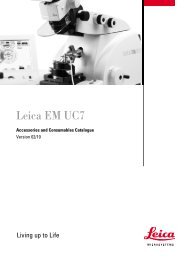Physical Principles of Electron Microscopy: An Introduction to TEM ...
Physical Principles of Electron Microscopy: An Introduction to TEM ...
Physical Principles of Electron Microscopy: An Introduction to TEM ...
Create successful ePaper yourself
Turn your PDF publications into a flip-book with our unique Google optimized e-Paper software.
88 Chapter 3<br />
A related concept is depth <strong>of</strong> field: the distance �u (along the optic axis)<br />
that the specimen can be moved without its image (focused at a given plane)<br />
becoming noticeably blurred. Replacing the <strong>TEM</strong> imaging system with a<br />
single lens <strong>of</strong> fixed focal length f and using 1/u + 1/v = 1/f , the change in<br />
image distance is �v = � (v/u) 2 �u = � M 2 �u (the minus sign denotes a<br />
decrease in v, as in Fig. 3-15b). The radius <strong>of</strong> the disk <strong>of</strong> confusion in the<br />
image plane (due <strong>to</strong> defocus) is R = ���v� = (�/M) (��v) = � M �u,<br />
equivalent <strong>to</strong> a radius �r = R/M = ��u at the specimen plane. This same<br />
result can be obtained more directly by extrapolating backwards the solid ray<br />
in Fig. 3-15b <strong>to</strong> show that the electrons that arrive at a single on-axis point in<br />
the image could have come from anywhere within a circle whose radius<br />
(from geometry <strong>of</strong> the <strong>to</strong>pmost right-angle triangle) is �r = ��u.<br />
If we take � = 5 mrad and set the loss or resolution �r equal <strong>to</strong> the <strong>TEM</strong><br />
resolution (� 0.2 nm), we get �u = (0.2 nm)/(0.005) = 40 nm as the depth <strong>of</strong><br />
field. Most <strong>TEM</strong> specimens are <strong>of</strong> the order 100 nm or less in thickness. If<br />
the objective lens is focused on features at the mid-plane <strong>of</strong> the specimen,<br />
features close <strong>to</strong> the <strong>to</strong>p and bot<strong>to</strong>m surfaces will still be acceptably in focus.<br />
In other words, the small value <strong>of</strong> � ensures that a <strong>TEM</strong> image is normally a<br />
projection <strong>of</strong> all structure present in the specimen. It is therefore difficult or<br />
impossible <strong>to</strong> obtain depth information from a single <strong>TEM</strong> image. On the<br />
other hand, this substantial depth <strong>of</strong> field avoids the need <strong>to</strong> focus on several<br />
different planes within the specimen, as is sometimes necessary in a ligh<strong>to</strong>ptical<br />
microscope where � may be large and the depth <strong>of</strong> field can be<br />
considerably less than the specimen thickness.<br />
3.6 Vacuum System<br />
It is essential <strong>to</strong> remove most <strong>of</strong> the air from the inside <strong>of</strong> a <strong>TEM</strong> column, so<br />
that the accelerated electrons can follow the principles <strong>of</strong> electron optics,<br />
rather than being scattered by gas molecules. In addition, the electron gun<br />
requires a sufficiently good vacuum in order <strong>to</strong> prevent a high-voltage<br />
discharge and <strong>to</strong> avoid oxidation <strong>of</strong> the electron-emitting surface.<br />
A mechanical rotary pump (RP) is used in many vacuum systems. This<br />
pump contains a rotating assembly, driven by an electric mo<strong>to</strong>r and equipped<br />
with internal vanes (A and B in Fig. 3-16) separated by a coil spring so that<br />
they press against the inside cylindrical wall <strong>of</strong> the pump, forming an airtight<br />
seal. The interior <strong>of</strong> the pump is lubricated with a special oil (<strong>of</strong> low vapor<br />
pressure) <strong>to</strong> reduce friction and wear <strong>of</strong> the sliding surfaces. The rotation<br />
axis is <strong>of</strong>fset from the axis <strong>of</strong> the cylinder so that, as gas is drawn from the<br />
inlet tube (at A in Fig. 3-16a), it expands considerably in volume before<br />
being sealed <strong>of</strong>f by the opposite vane (B in Fig. 3-16b).



